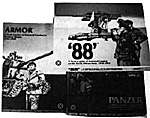 ED NOTE: It is normally against the policy
of THE COURIER to review board games but
these are so miniature oriented in play we felt we
could make an exception.
ED NOTE: It is normally against the policy
of THE COURIER to review board games but
these are so miniature oriented in play we felt we
could make an exception.
Last year, when I first read the rules of Yaquinto Publications game "Panzer", I felt the rules were as much miniatures rules as board game rules; and nothing in the two other games released in this series has changed my mind. Of the three games, the first -- "Panzer" - is set on the Russian Front between 1943 and 1945; "88" covers 1941 -1942 in North Africa; and their latest, "Armor", treats the Western Front from mid 1944 to mid 1945. Physicaily the components are of high quality.
The counters are about 1/8th inch thick, making handling easier, and are printed with silouettes for individual vehicles, guns and squads of infantry. The mapboards are geomorphic and are printed on heavy stock to minimize wear. The terrain on the boards consists of depressions, scrub, rough, defilade positions, streams and crest lines but no hills, woods or buildings.
The hills etc., are on sheets like the counters and are placed about the board at the discretion of the players. In addition, the woods, hills and building counters may he placed on larger hill pieces giving a variety of multilevel terrain. With the variety of terrain, one might suppose pages of sighting rules, but the whole thing is neatly handled with a couple of sighting matrixes.
Each of the various guns, tanks, planes, trucks and infantry in the game are represented with data cards. These cards contain the movement speeds, gunnery tables, and target information as well as other information about the units present in the game.
Armored combat is a matter of cross indexing the firing gun's accuracy factor at the particular range with a base factor modified for terrain, movement, size and other factors; to generate a percent chance of hitting. Once a vehicle is hit, a roll is made to determine the location of the hit at the targets aspect and elevation. If the penetration factor of the gun at that range equals or exceeds the armor factors at the hit location, the round penetrates and may disable or destroy the vehicle. Again well laid out tables and modifiers speed this process
The basic scenarios are solely a confrontation of armor; infantry and anti-tank guns are added in the advanced scenarios and the addition of various optional rules (there are 31 optional sections in the Armor rules), the games may be made more complex. Special vehicles (Armor and 88), airborne assault (Armor), artillery and aircraft may be added. The rules may be modified to account for gun depression, morale, and brigades that won't hold heavy tanks. It is even possible to add armor with tracks and sandbags.
The games are designed to be played with a small number of units, usually 10-15 per person.
This is, in part, due to the nature of the movement system. Movement and fire are simultaneous, all actions being plotted at the start of each turn. In order to minimize plotting time the number of units must be kept small.
These games fall on the dividing line between miniatures and board games. Very few miniatures rules for this period are more detailed and yet handled as easily as the rules for these games. Overall, these games are well designed and rank among the best tactical armor games. The prices on these games are: Panzer, $16.00; "88", $17.00; and Armor $16.00.
More Reviewing Stand
-
Jim Womer, New Reviewing Stand Editor (bio)
Jacobite 15mm Napoleonics (figures)
Alexander the Great's Campaigns (book)
Wargames Rules 3000BC to 1485 (6th ed)
Ace of Aces (WWI game)
Yaquinto WWII Board/Miniatures Games
Engage and Destroy (modern mini rules)
Sword Beach (WWII Campaign Game)
Back to Table of Contents -- Courier Vol. 2 #3
To Courier List of Issues
To MagWeb Master Magazine List
© Copyright 1980 by The Courier Publishing Company.
This article appears in MagWeb (Magazine Web) on the Internet World Wide Web.
Other military history articles and gaming articles are available at http://www.magweb.com